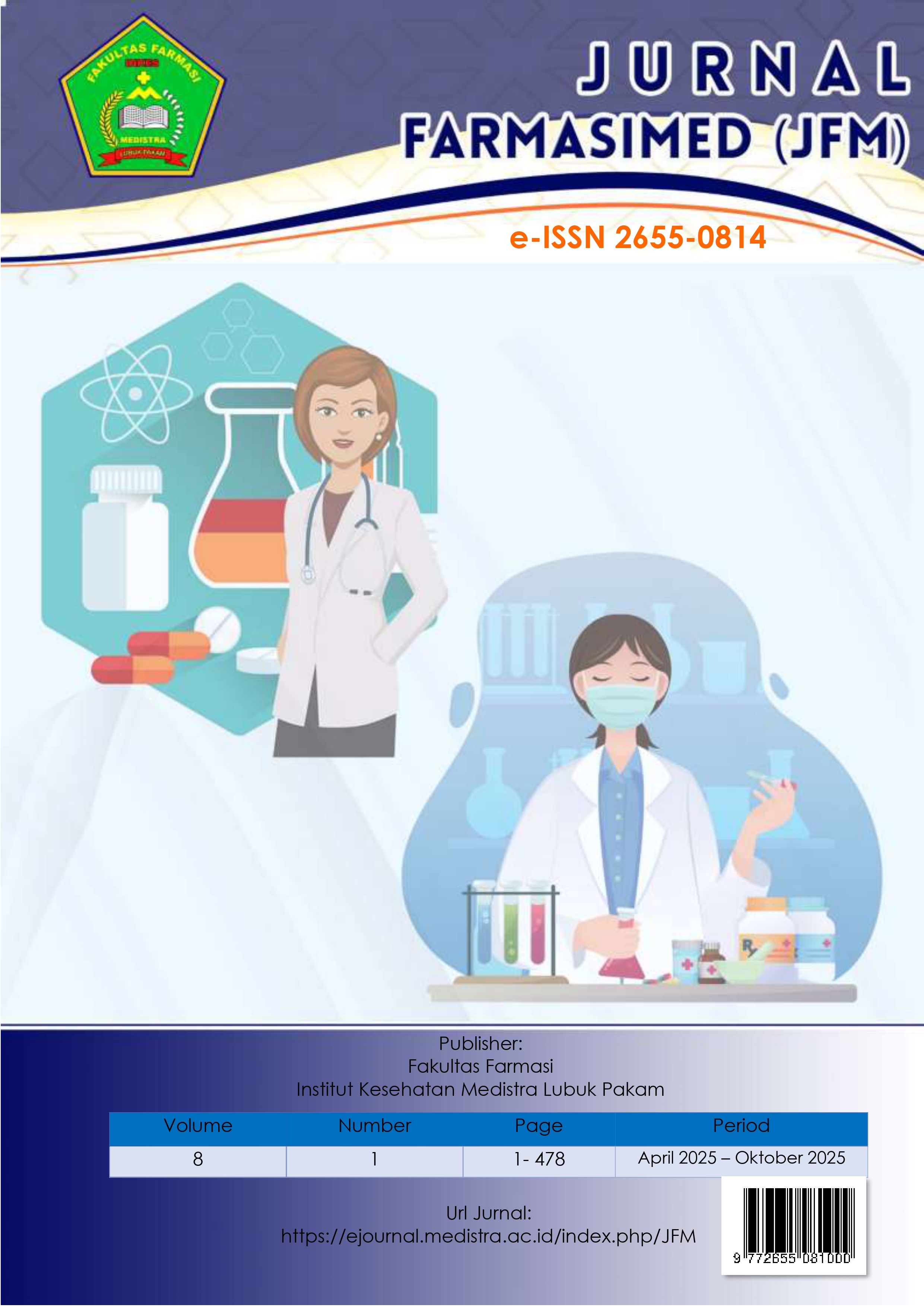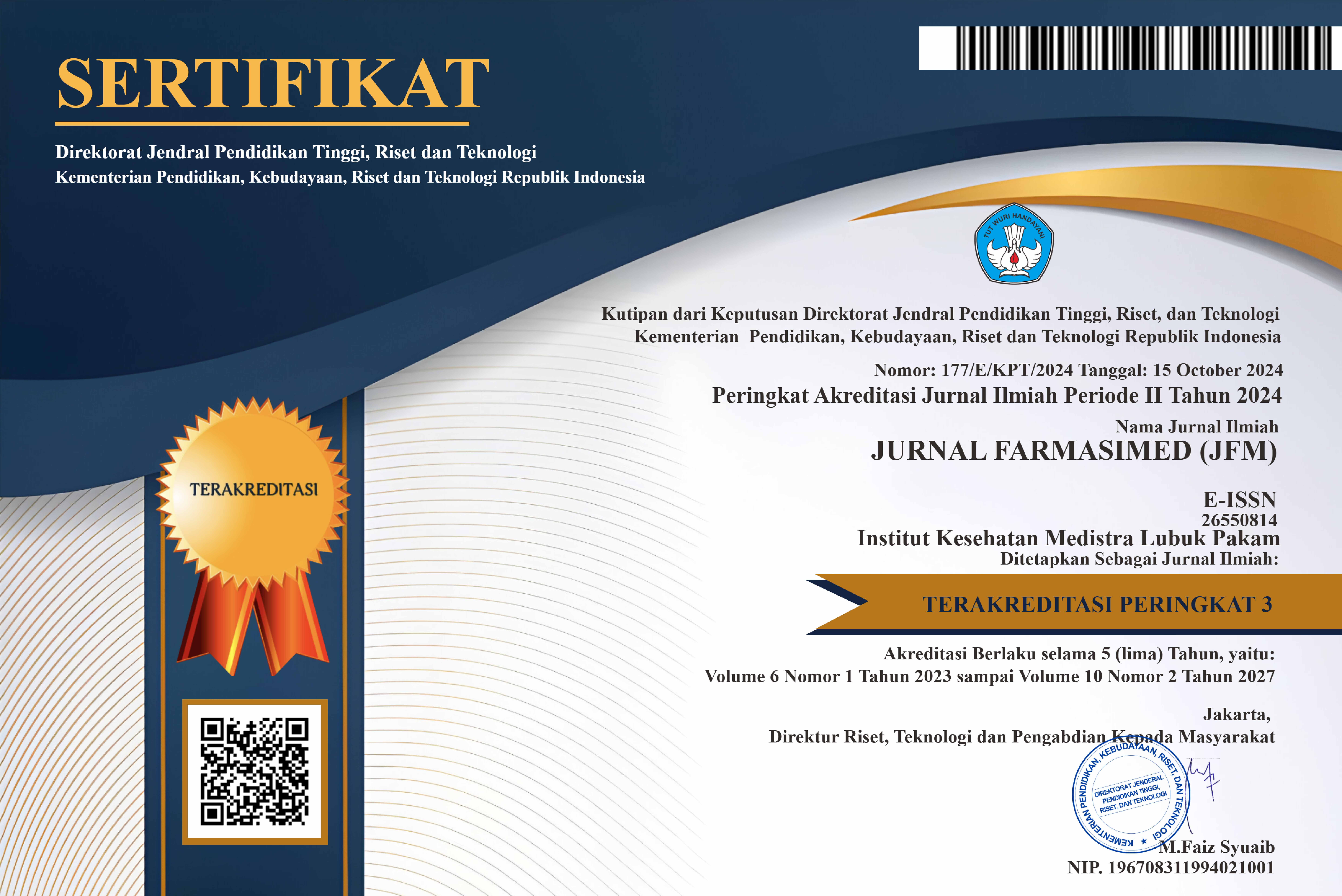Antibiotic Use in Inpatients with Diarrhea in Children: A Quantitative Evaluation at Hospital X, Semarang Regency, 2023
DOI:
https://doi.org/10.35451/s8qfqn40Keywords:
Children, Antibiotics, ATC/DDD, Diarhea, DU 90%Abstract
Background : Infection remain one of the leading causes of morbidity in tropical regions such as Indonesia, with Escherichia coli being one of the most freequently identified pathogens. The high incidence of Escherichia coli-related infections has led to increased antibiotics use, considering that this commensal gut bactericum can cause both asymptomatic infections and symtomatic diarrhe, either bloody or non-bloody. Objective : This study aimed to evaluate use in pediatric patiens with diarrea at Hospital X, Semarang Regency, in 2023. Methods: This was a retrospective study uutilizing medical records of 323 pediatric patiens who met the inclusion and exclusion criteria. Data analysis was performed using the Anatomical Therapeutic Chemical/Defined Daily Dose (ATC/DDD) methodology. Result:The analysis revealed that Ceftriaxone injection was the most frequently used antibiotic (61.95%), followed by Ampicillin, Amikacin, Gentamicin, and Cefotaxime. Ceftriaxone was often prefered due to its efficacy against both gram-positive and gram-negative bacteria comonly associated with pediatric diarrhea, as well as the advantage of accurate dosing trough injectable formulations. Most diarrhea cases occurred in boys (62.54%) and in children under five years of age (65.63%). Conclusion:Injectable formulations were chosen to reduce the risk of vomiting and to facilitate precise and effective dosing. Evaluation using the ATX/DDD method highlighted the need for more rational antibiotic management to prevent bacterial resistance in the future. Optimizing antibiotic stewardship is crucial to ensure targeted in the future. Optimizing antibiotic stewardship is crucial to ensure targeted, effective use and to preserve therapeutic efficacy in the long term.
Downloads
References
1. Jap ALS, Widodo AD. Diare Akut yang Disebabkan oleh Infeksi. J Kedokt Meditek. 2021 Sep;27(3):282–8.
2. Zollner-Schwetz I, Krause R. Therapy of acute gastroenteritis: role of antibiotics. Clin Microbiol Infect. 2015 Aug;21(8):744–9.
3. Dipiro, J. T., Yee, G. C., Posey, L. M., Haines, S. T., Nolin, T. D., Ellingrod V. Pharmacoterapy: A Pathophysiologic approach (11th ed.). Inggris: McGraw-Hill Education Companie; 2021.
4. Saputri N, Astuti YP. HUBUNGAN FAKTOR LINGKUNGAN DENGAN KEJADIAN DIARE PADA BALITA DI PUSKESMAS BERNUNG. J Ilmu Keperawatan dan Kebidanan. 2019 Jan;10(1):101.
5. WHO. Acute Diarrhea in Adults and Children: A Global Persppective. UK: World Gastroenterology Organisation; 2012.
6. Kementrian Kesehatan Republik Indonesia. Keputusan direktur jendral pencegahan dan pengendalian penyakit nomor HK.02.02/C/2934/2022 tentang rencana aksi program pencegahan dan pengendalian ppenyakit tahun 2020-2024. 2022;
7. Kementrian Kesehatan Republik Indonesia. Pedoman algoritma aiatem kewaspadaan dini dan respon (SKDR). 2022;
8. Tansri S, Rahmi Makmur. TINGKAT PENGETAHUAN ORANG TUA TERHADAP PENGGUNAAN ANTIBIOTIKA PADA ANAK. J Kesehat Yamasi Makassar. 2024 Feb;8(1):117–28.
9. Novita RP, Amriani S A, Wijaya DP, Novelia D. Evaluasi Penggunaan Antibiotika pada Pasien Anak dengan Diare Akut. J Penelit Sains. 2023 Mar;25(1):56.
10. Rahayu YS, S. W. Evaluasi Kualitatif Penggunaan Antibiotik Ceftriaxone pada Pasien Demam Tifoid Anak Ruangan Rawat Inap RSUD Deli Serdang. J Farm. 2021;47–52.
11. Satrianjaya IDM, Nesa NNM, Mahalini DS. Karakteristik diare pada anak di RSUP Sanglah Denpasar tahun 2017. Intisari Sains Medis. 2019 Jun;10(2).
12. Lestiono., Kresnamurti, A., Aziz, A., Wahyudi ME. Evaluasi penggunaan antibiotika dengan metode defined daily dose pada pasien gastroenteritis anak di rs swasta Surabaya. J Ilmu Farm dan Farm Klin 19(2), 81-87. 2022;
13. Sugiarto S, Pitriyani S, Pitriyani P. FAKTOR RISIKO KEJADIAN DIARE PADA BALITA. Contag Sci Period J Public Heal Coast Heal. 2019 Jun;1(01).
14. Wang P, Asare EO, Pitzer VE, Dubrow R, Chen K. Floods and Diarrhea Risk in Young Children in Low- and Middle-Income Countries. JAMA Pediatr. 2023 Nov;177(11):1206.
15. Rukminingsih F, Apriliyani A. ANALISIS PENGGUNAAN ANTIBIOTIK PADA PASIEN ANAK DI RUANG THERESIA RUMAH SAKIT ST. ELISABETH SEMARANG DENGAN METODE ATC/DDD. J Ris Kefarmasian Indones. 2021 Jan;3(1):26–34.
16. Pusporini R. Antibiotik kedokteran gigi: pedoman praktis bagi dokter gigi. Malang: UB Press; 2019.
17. da Cruz Gouveia MA, Lins MTC, da Silva GAP. Acute diarrhea with blood: diagnosis and drug treatment. J Pediatr (Rio J). 2020 Mar;96:20–8.
18. Mandeel, H. A., Jassim, A. S., Naeem AK. Prevalence of Enterohaemorrhagic and enteroaggregative E. coli among children with diarrhea in najaf, Iraq. Arch Razi Institue, 77(5), 1655-1658 https//doi.org/1022092/ari20223577552097. 2022;
19. Anggraeni R, H. S. Evaluasi Penggunaan Antibiotik Di Puskesmas Dalu Sepuluh Tanjung Morawa. J Farm. 2023;122–6.
20. Meirita E, A. S. Evaluasi rasionalitas Penggunaan Antibiotik Pada Pasien Diabetes Melitus Tipe II di Instalasi Rawat Inap Rumah Sakit Grandmed Lubuk Pakam Tahun 2022. J Farm. 2022;73–9.
21. Monica C, S. A. Evaluasi Drung Related Problems (DRPs) Antibiotik pada Pasien Pneumonia Rawat Inap Anak Rumah Sakit Umum Daerah Deli Serdang. J Farm. 2021;63–8.
22. Rachmawati E, Husnun KH, Machlaurin A, Norcahyanti I, Christianty FM, Aryani DE. Evaluasi Penggunaan Antibiotik pada Pasien Diare Menggunakan Metode ATC/DDD di Puskesmas Kalisat Kabupaten Jember. Farm J Sains Farm. 2024 Mar;5(1):23–31.
23. Rizky VA, S. S. Identifikasi Bakteri Escherichia coli o157:H7 Pada Feses Penderita Diare Dengan Metode Kultur dan PCR. J Farm. 2021;118–23.
Downloads
Published
Issue
Section
License
Copyright (c) 2025 Zulfia Widiastuti, Avianti Eka Dewi Aditya Purwaningsih, Amalia Nurul Ulum

This work is licensed under a Creative Commons Attribution-NoDerivatives 4.0 International License.
Copyright in each article is the property of the Author.

























